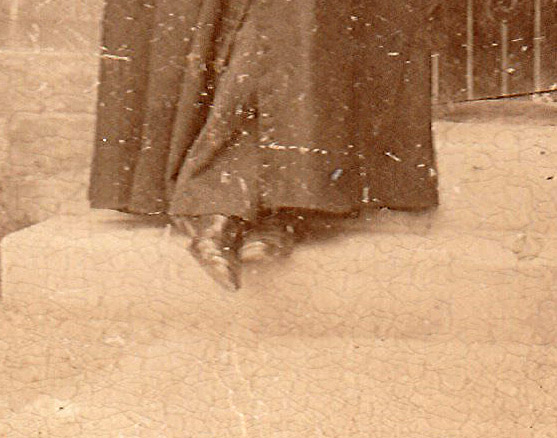
As a change from most of the cartes-de-visite featured previously in this series, this week’s CDV is not a studio portrait but rather a nicely-composed photograph that has been taken outside. It shows a clergyman in cassock and biretta, standing by an open door, possibly of a church building. A pencilled scrawl on the back records the name of ‘Revd. Philip Vavasour’ but no other details. However, I am not short of books on Victorian church history, and a little bit of digging soon unearthed some more information about the subject of this portrait.
Philip Joseph Vavasour (1826-87) was actually born Philip Joseph Stourton, but only had this surname for one day! Philip was born on 26 February 1826, the eighth child, and fifth and youngest son of Hon. Sir Edward Marmaduke Joseph Stourton and his wife, Marcia Bridget Lane-Fox. The following day his father changed his surname to Vavasour by royal license, in line with a testamentary injunction from his late cousin, Sir Thomas Vavasour, 7th Baronet, who had died the previous month. Although the baronetcy became extinct with the death of Sir Thomas, his estate of Hazelwood in the West Riding of Yorkshire, passed to Sir Edward, who was created 1st Baronet Vavasour of Hazelwood in 1828. Sadly, his wife did not live to see this, as she died in June 1826, possibly from complications following the birth of her eight child.
They were a deeply pious family, spending much time in religious devotion and acts of charity. Two of Philip’s sisters became nuns. Tragedy struck again when Sir Edward died while making a pilgrimage to Rome, collapsing on 16 March 1847 at the village of Chanceau in France, where he was buried.
Philip at this time was studying for the priesthood at Ushaw College, and was ordained in 1850. The same year he travelled over to France and spent a week at Chanceau, a journey he made several times to visit his father’s grave. In 1876 he made one final trip, and brought his father’s remains back to be reinterred at Hazelwood.
Philip was chaplain of St Leonard’s, the medieval chapel at Hazelwood, but held another posts around the diocese and was instrumental in raising funds for the construction of St Wilfrid’s Catholic Church in Ripon, where he became the first parish priest in 1862. He would hold this position until his death.
He also helped raised funds to construct a new Catholic church at Tadcaster – near Hazelwood – on land donated by the Vavasour family. A temporary chapel opened there in 1865 with Cardinal Manning presiding at the opening of St Joseph’s Catholic Church four years later. a more permanent structure opening. There is a memorial to Fr. Philip Vavasour there in the form of a stained glass window by the altar.
St Anne’s Catholic Cathedral in Leeds had been established in 1838 on a site in Park Terrace, at the junction of Cookridge Street and Guildford Street. Fr. Vavasour was made a canon of the cathedral sometime in either the late 1860s or early 1870s.
He was elected a member of the Leicestershire Archaeological and Historical Society in 1862, and was possibly also a member of the Royal Archaeological Institute, as he exhibited an embroidered medieval chasuble at one of their meetings in 1874. In addition to these scholarly interests, he was well-known in the area for his charitable work, and was prominent among the social events of the local Catholic gentry and aristocracy, including the Marquis of Ripon. He was of course related to many of the well-known Catholic families.
Canon Vavasour travelled down to London in the company of Lord Ripon on Monday 18 April to attend a meeting of the Catholic Poor Schools Committee and also a reception with Cardinal Manning. To everyone’s shock, he collapsed and died the next day while visiting his relative, Miss Langdale, at 52 South Street, Park Lane. He was 61 years old. His body was interred at Hazelwood, where the funeral was carried out by the Bishop of Clifton. A memorial window was installed at St Wilfrid’s, Ripon, the following year.
Where was the photograph taken? The two most probable places would seem to be either a side door at the cathedral, or – more likely – St Wilfrid’s Church, Ripon. Verifying the first option is difficult, as the old cathedral was demolished and replaced by the present building in 1904. I stayed overnight in Ripon some years ago and went to Mass at St Wilfrid’s, but cannot recall this doorway. If anyone can confirm the location, I’d be interested to hear from them. One of the things that struck me about the portrait was the way Canon Vavasour is standing on the step, one foot crossed over the other, leaning back against the pillar of the door. The casual self-assurance, and disinterest in adhering to the stiff formalities of ecclesiastical portraiture, possibly reveal a little of the character of the man.
